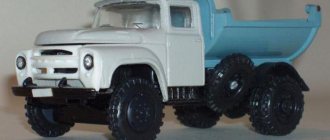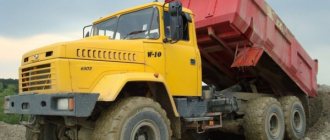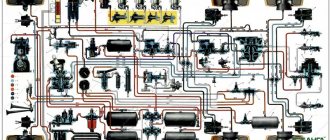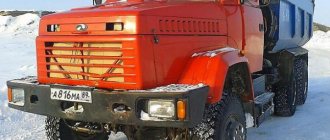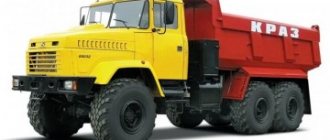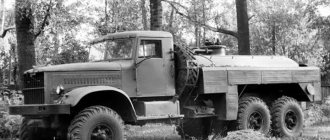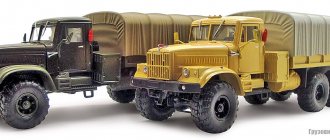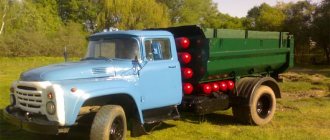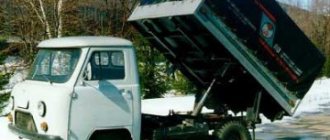The KrAZ-256 is a Soviet dump truck that replaced the earlier YaAZ and KrAZ-222 trucks in 1966. The car became the debut post-war heavy-duty vehicle.
Due to its massive dimensions, it was almost never used in the city, but it still works in quarries, mining and oil production enterprises to this day. The model was produced for 11 years, after which KamAZ trucks pushed our giant aside a little. The entire KrAZ model range.
The production of vehicles began in 1986, but out of the 18 cars that appeared at that time, not a single copy has survived to this day. However, in the automobile market it is possible to find cars that were produced in their debut 11 years. The truck has a large carrying capacity, a large mass of components (since most parts were made of cast iron), and also high cross-country ability.
Options and modifications of the KrAZ-256 dump truck
- KrAZ-256 (1960-1966) – basic model, dump truck with a lifting capacity of 12 tons and a YaM3-2Z8 diesel engine with a power of 215 hp.
- KrAZ-256B - (1966-1977) - a modernized dump truck with a YaM3-2Z8 engine with a power of 240 hp.
- KrAZ-E256BS (1967) and KrAZ-256BS (1969-1980) are special modifications of the KrAZ-256 dump truck, adapted for work in the Far North. They differ from conventional machines of this model in frost-resistant rubber products, an improved cabin with thermal insulation and a special powerful heater. Relatively few such cars were produced: about 2,000 units over all years of production.
- KrAZ-256B1 (1976-1994) - a modernized dump truck with a new hydraulic mechanism for tipping the body, an increased working life of the engine and main components/assemblies, the presence of a separate brake drive and a starting heater for the PZD-448 engine; a number of other minor improvements.
- KrAZ-256B1S (1981-1994) - serial modification of the KrAZ-256B1, intended for operation in the Far North. The last such car was manufactured in January 1994, and a total of 11 7O2 units were produced over the years of production.
- KrAZ-256B1-030 (1986) – a special modification of the KrAZ-256B1, made for the removal of radioactive waste during the liquidation of the consequences of the accident at the Chernobyl nuclear power plant. Instead of a standard cabin, there is a single-seater sealed capsule, lined with lead, anti-radiation crystal glass 75 mm thick and an FVU-1OON filter and ventilation unit, a reinforced and enlarged body. 18 of these vehicles were made.
- KrA3-256B1G (1986-1987) - a joint development of KrAZ, YaMZ and NAMI, which did not progress beyond the creation of two prototype vehicles. This vehicle used a modified YaMZ-E238M engine. In addition to the standard diesel engine power system, it had a gas-diesel power system.
- KrAZ-256B1M - Soviet-made KrAZ-256B, modernized at the Cuban auto repair plant Cienfuegos, a joint Ukrainian-Cuban venture "KrA3-S0MEC", using repair kits for the KrAZ-6510. This vehicle was equipped with a new all-metal cabin and a more modern modification of the YaMZ-238M2 diesel engine. During 2008-2014, more than three hundred old Soviet KrAZ-256B dump trucks operating in Cuba were converted into this modification.
Modifications
Since during the period from the 70s to the 90s the Soviet leadership invested huge amounts of money in the development of heavy equipment, the KRAZ 256 was produced in huge quantities and in various variations. It is almost impossible to count how many vehicles were produced, since only one model KRAZ-256B1S has almost twelve thousand copies.
The KRAZ series has the following modification options:
- The first KRAZ 256 dump truck was produced in 1960 and was equipped with a power plant with a power of 215 hp.
- The second product of the plant is the twelve-ton KrAZ-256B unit, whose power is 240 hp. Even today, such indicators indicate a high degree of productivity.
- At the end of the 60s, engineers presented a unique model of the KrAZ-E256BS, designed to work in the harsh conditions of the Northern regions of the country. After some successful tests, it was decided to launch the “snowmobile” into mass production.
- KRAZ-256BS was also developed for the needs of hard-to-reach areas of the USSR, where vehicles with increased cold resistance and cross-country ability were required.
- The KrAZ-256B1 was a conventional twelve-ton dump truck with separate brake drives.
Interesting fact: in 2008, the Cuban leadership began negotiations with Ukraine on the creation of a special joint project for the repair and modification of the KRAZ 256 dump truck. Today, there are about three thousand trucks in Cuba that need repairs and can be used in the future for government orders. As of 2014, the Cuban company, together with the Kremenchug plant, has modernized about three hundred all-terrain vehicles.
Some KRAZ 256 models were developed specifically for operation in the Far North
In addition to the main car models, a special unit KRAZ-256B1-OZO was created for the removal of radioactive waste from the Chernobyl zone. The purpose of the dump truck speaks for itself, so it is equipped with a maximum degree of radiation protection, durable glass and has increased load capacity. In total, about twenty of these machines were produced, which today have not been used for a long time and, in most cases, have been disposed of.
More information about northern modifications of KrAZ-256 / 256B / 256B1 dump trucks
The engine of northern modifications has an electromagnetic clutch for the motor fan, which turns it off at low temperatures. Instead of radiator blinds, a thick curtain was used. The standard equipment of the dump truck includes a powerful and efficient pre-heater.
Northern dump trucks were equipped with more powerful BTST-165ZMS batteries, plus the battery box itself was insulated from the inside with foam inserts, and was equipped with an additional tray from the outside at the bottom. Part of the engine exhaust gases passed through it, heating the battery compartment.
The fuel tank was also equipped with a segmented pan through which exhaust gases passed, heating it. In addition to the main fuel tank, a second tank with a capacity of 80 liters was installed. It was intended for TC-I aviation kerosene to be used for starting and preheating the engine.
The cabin of the northern modifications of the most popular KrAZ dump truck was additionally insulated. Thick quilted mats filled with synthetic fiber were used to upholster the cabin. The floor was additionally insulated with rubber mats.
Until 1973, the cabins of KrAZ-256 “polar explorers” had double glazing: windshields in the form of sealed double-glazed windows with silica gel embedded in their internal space, which prevented the glass from freezing.
In 1973, by order of KrAZ, he developed and began supplying electrically heated windshields to Kremenchug, especially for northern modifications. This is a more technologically advanced solution compared to double glazing filled with silica gel. The door glass was removable and could be dismantled in the summer. Operating experience in the Arctic Circle (in particular, in Norilsk) showed that the driver of the KrAZ-256B of the northern modification, even in 45-degree frost, could work in the cockpit without a hat, sheepskin coat and thick mittens.
Expansion of the model range
From the very beginning of serial production, the KrAZ-255B was positioned as the base model, on the basis of which a family of trucks for various purposes began to be formed.
The first of its “brothers” was the KrAZ-255V truck tractor, which was intended for towing semi-trailers weighing up to 26 tons with a maximum load on the saddle of 8 tons. In the civilian version, the tractor was mainly used as a trailer version transporting tracked construction equipment. A significant number of tractors were supplied to units of the Soviet Army, where they were used to tow semi-trailers with special equipment and rocket and artillery weapons.
truck tractor KrAZ-255V
The third vehicle in the 255 family was the industrial timber carrier KrAZ-255L, the production of which was mastered by factory workers in 1969. The timber carrier became the only all-wheel drive truck produced at the Kremenchug Automobile Plant, intended only for the needs of the country's national economic complex. Complete with a TMZ-803 trailer-trailer produced by the Tavdinsky Machine-Building Plant, the timber tractor-trailer was intended to transport up to 40 cubic meters of round timber. The unloaded trailer could be transported on a tractor platform.
In the same 1969, an interesting modification of the KrAZ-255BS appeared in the northern version. This machine was not mass-produced, but one of its curious elements soon appeared on all production Laptezhniks. The mentioned element is special extensions on the front fenders in which the headlights were installed. Because of their box-shaped shape, these extensions were nicknamed birdhouses. These extensions, with their empty eye sockets and the absence of an optical element, really resembled birdhouses.
Today it is almost impossible to imagine KrAZ without these very “birdhouses”, and hardly anyone now remembers the first versions of the 60s without this simple element. Thus, the northern version, which never went into production, contributed to the appearance of this characteristic “calling card” on all KrAZ trucks produced in the 70s and 80s.
Later, next to the “birdhouses” on the front wings of all-terrain vehicles, special dimensional indicators appeared in the form of a spring pin with a plastic spherical tip. This element is called a “mustache” among drivers. Dimensional pins helped the driver maneuver. After the 255 family began to be equipped with two wide rectangular rear-view mirrors, the classic, familiar image of the Kremenchug “Laptezhnik” was finally formed.
Differences between the KrAZ-256 and its predecessor: KrAZ-222
In addition to the new four-stroke rather than two-stroke diesel engine, the KrA3-256 dump truck differed from its predecessor, the KrA3-222, in more modern steering and a different suspension design of the front and rear wheels (the front one had a telescopic shock absorber instead of a lever one, and the rear balancing trolley had a modified kinematics, to prevent wear of the main leaf springs).
In the gearboxes of the drive axles, helical gears of a cylindrical pair were used instead of spur gears; in the suspension of the power unit, the flat rubber support cushion gave way to a new W-shaped one.
The predecessor's weak point was the gearbox. In difficult operating conditions, gears and gear shift synchronizers in the gearbox often failed. To a large extent, this was facilitated by large gear ratios of the stages. Therefore, a new gearbox was used on the KrA3-256, the gear teeth of which were strengthened and the gear ratios in the stages were reduced.
KrAZ-222.
The KrA3-256 was equipped with an improved driver's seat and higher capacity batteries (up to 165 ampere/hour). In the electrical system, instead of a direct current generator, a more reliable alternating current generator was used.
The rear lights, to extend the life of the light bulbs, began to be mounted on an elastic suspension, more protected from vibrations. A moisture and oil separator appeared in the brake system of the dump truck, flexible elements were introduced in the pipelines of the brake cylinders of the drive axles, the design of the reaction rod hinges and the sealing of the axle were changed. Flexible hoses appeared in the engine exhaust system, the subframe was strengthened and a new dump platform with a volume of 6 m3 was installed.
Advantages and disadvantages of the car
Reviews of the KrAZ-65055 are mostly positive: no complaints about the assembly, body, or power unit. Even a few extra tons of cargo above the norm will not disable the dump truck.
Advantages of a dump truck:
- excellent load capacity, the machine behaves confidently when normally loaded;
- no need for frequent repairs (the distance between major repairs is 250 thousand km, but practice shows that this is not the limit);
- low fuel consumption, like for a heavy truck;
- convenience of the interior and location of controls;
- powerful motor.
Disadvantages of a dump truck:
- weak heating (you can install heaters of other brands, more powerful);
- poor sound insulation.
It is a mistake to believe that in light of recent events, original spare parts are difficult to obtain through dealerships. Moreover, this is not a reason to sell the dump truck: the catalog includes Russian-made parts (YaMZ).
About the history of the model and its upgrades over the years of production
So, the KrAZ-256 was developed on the basis of the heavy KrAZ (YAZ)-222 dump truck, which the Kremenchug enterprise “inherited” from the Yaroslavl Automobile Plant, when the production of heavy trucks was transferred from one plant to another (in 1959). Work on creating a new, modernized dump truck based on the 222nd model began in the early 60s.
There is an article about this in the October 1961 issue of Behind the Wheel magazine. It says that the KrAZ-222 already needs a “successor”: its two-stroke diesel engine YaAZ-206 does not produce enough power; the rear suspension does not provide satisfactory adaptability of the car to road conditions; front suspension lever shock absorbers are ineffective and often fail; The sound absorption of the muffler is weak, and the power it takes from the power unit is large, etc.
Further, the most authoritative Soviet magazine says that the KrAZ-222 dump truck will be replaced by the KrAZ-256; the KrAZ-219 general purpose vehicle will be replaced by the modernized KrAZ-257; and the new generation KrAZ-258 truck tractor will replace the KrAZ-221 on the assembly line of the plant. The start of production is scheduled for 1963.
As a result, the KrAZ-256 entered the assembly line of the Kremenchug Automobile Plant in May 1966 and stayed there for a long time. Its predecessor KrA3-222 remained in mass production for another two years, until the Yaroslavl engine was completely rebuilt from the production of obsolete two-stroke diesel engines YaMZ-206 to the new four-stroke YaMZ-238. The 222nd and 256th KrA3s rolled off the assembly line together until mid-1968.
The bucket is clearly too big for the KrAZ-256 body, but what can’t you do for a good photo!
In 1969, KrA3-256 cars began to look different: they lost the archaic separate system for placing lighting equipment. The headlights and turn signals were no longer attached separately to the wings, but began to be installed together, in a special box-shaped extension on the wing, nicknamed the workers.
In the same year, KrA3-256 dump trucks received a new, more technologically advanced cylindrical fuel tank with a volume of 165 liters instead of a rectangular one with a volume of 225 liters and two rectangular rear-view mirrors with an increased viewing area (instead of one small square one).
In 1972, in accordance with the requirements of GOST, side turn indicator repeaters appeared on the sides of the front wings of the car. In the same year, double-lip seals began to be installed on the output shafts of the transfer case, drive axles and intermediate support to eliminate oil leaks in these units. In 1974, the KrA3-256B1 dump truck was awarded the USSR State Quality Mark. In the mid-1970s, the serial KrAZ-256B was supplemented with a new dual-circuit braking system.
A large number of heavy KrAZ-256B1 and imported Magirus-Deutz dump trucks were involved in the construction of BAM. In comparison with the products of the German automobile industry, KraZs were inferior in comfort and efficiency, but in general they proved to be more cost-effective, unpretentious and durable vehicles. At KrAZ, the driver earned a salary 30-40% higher than at Magirus.
With the parallel operation of a large number of KrAZ and Magirus trucks, comparisons naturally arose, and many changes in the design of the Kremenchug dump truck during this period occurred due to operating experience at BAM. They were completed with a reinforced body, frame and subframe, new extended windshield wiper blades, improved heating and cabin sealing. Elements of the KrAZ-256B dump truck began to be welded together using a continuous seam instead of the intermittent one used previously. Additionally, the capacity of the batteries was increased and the design of the hood insulation was changed.
KrAZ-256b and Magirus Deutz-290 work side by side at BAM.
Of course, not only the Baikal-Amur Mainline is on the track record of the KrAZ-256, but also the Urengoy - Pomary - Uzhgorod oil pipeline, and many other important construction projects of socialism. But it was during the time of BAM that the KrA3-256 dump truck became the most popular model in the history of the Kremenchug Automobile Plant. The maximum annual production was achieved in 1980 - 11,564 dump trucks.
By 1975, the electrical equipment of the KrAZ-256B was unified with the electrical equipment of other Soviet trucks (all automobile factories) by more than 70%. In 1976, they began to manufacture components of platforms and cabins using arc spot welding. By 1980, 66% of the materials on the KrA3-256B1 platform were bent sections, and the use of low-alloy steels had decreased to 25 percent.
Improvements in design led to an increase in the service life of cars: until 1970 it was set at 1000 thousand km, in 1970 - 1976 - 15000 km. km, and in 1977 - 1982 - 16,000 km. In 1985, the service life of serial KrA3ov-256B1 was increased to 165,000 km.
Story
From the very beginning, the enterprise in Kremenchug was built to produce heavy-duty, heavy trucks. Initially, the 222 machine, which was given the name "Dnepr-222", was produced throughout the 1950s of the twentieth century.
6 years later, the KrAZ-256 was demonstrated, which acquired the best developments of the 222nd model. The truck began to be used in quarrying or large-scale construction.
The main body was a bucket-type dump truck with no tailgates. On-board modifications of vehicles were also made on this platform, however, due to some issues, these vehicles did not receive further development.
Over the entire 11 years of production, the 256th model underwent some modernization, but the changes mainly affected only the cabin and hood. They decided not to change the main body.
The car has already been recognized many times as simple and unpretentious. Plus she's quite strong. However, driving the cargo model was also not very easy, since it required significant physical strength. Over these short years, the conveyor was able to produce many cars that had the same parameters.
The characteristics of the car changed only twice. For the first time, a truck was produced for the conditions of the Far North (there was an index “C” in the name). It had an insulated cabin and hood. The second was modification “B”, which had a split brake system.
The first batch of new trucks was assembled in 1961. The most important difference from previous cars was the power unit. Previously, such vehicles were equipped with two-stroke diesel engines.
But they decided to equip our new product with a four-stroke engine. Everything that was in the Union of Soviet Socialist Republics, which includes the auto industry, was all under the control of the Communist Party.
Therefore, in 1959, at the next 21st Party Congress, Yaroslavl engine builders received instructions to design a more productive and economical engine than a two-stroke engine.
A year later, a whole list of diesel power units was released, including the YaMZ-236, which had six cylinders, the YaMZ-240, which had twelve cylinders, and the eight-cylinder YaMZ-238. It was the 8-cylinder that they decided to install on the KrAZ-256.
The KrAZ was distinguished by its powerful appearance, good power plant and good cross-country ability, which made it a leader in its production years.
The issue began to actively develop in 1967. The enterprise in Kremenchug began to produce machines in serial order, where there was rear loading. For those times, such a vehicle had unusual technical characteristics, so it began to be widely used in quarries and construction sites.
After all, the angle of climb for the car was 38 degrees. The model had a 6x4 wheel formula. After a little time, it was replaced by the KrAZ-256B1, which was distinguished by a whole list of not so important upgrades and the presence of a separate brake drive. The machine was designed to operate on road sections of the 2nd and 1st categories, with an axle load of up to 10,000 kilograms.
The KrAZ-256 dump truck came with a two-cylinder hydraulic bucket-type body, where there was rear unloading. It was extremely powerful and reliable, and was not afraid of overloads. The bucket was unloaded in 20 seconds and lowered in about 30 seconds.
The first trucks were manufactured on a custom frame, using components from a motor plant in Yaroslavl. Such a powerful and passable dump truck was very necessary for the national economy of the Soviet Union, since there were simply no models of this class in those years.
Because of its reliable engine and simplicity of design, the KrAZ-256 was popular not only in the domestic market, but was also exported to other countries. The KrAZ-256 was exported to 55 countries as of 1978.
The company took into account not only the climatic conditions of the country exporting the car, but also the characteristics of road traffic. For example, for England, for operation in sand quarries, the model came with a right-hand drive design.
Southern countries received cars with a tropical design. Countries with a cold climate received double-layer cabin glass and frost-resistant rubber, and the power unit had a pre-heater.
During the mid-1970s, the technical design began to become outdated, because Yaroslavl trucks were also used as the basis for the 256th model. The latter, in turn, have been developed since the late 1940s.
Among the sore points, one can highlight controls that required significant physical strength, a massive frame made of rolled channels, which was not very strong. Also, the presence of a wood-and-metal cabin did not allow it to be used for so long.
If we compare the car with foreign rivals that appeared a little later, the 256th model looked like a “dinosaur”. In Germany, they released Magirus-Deutz, and in the Czech Republic, Tatra, which did not feature the latest solutions, but looked more preferable.
They envisaged a 251st model, which was supposed to replace the 256th, but its release was postponed. As a result, a full-fledged competitor to foreign copies was available only in the 1980s.
But no matter what, the first domestic heavy dump truck was able to forever remain in the history of Soviet mechanical engineering. The machine was a real hard worker and could be used for various bulk cargoes, and not only. KrAZ 256 tractor - some even used this vehicle in exactly this way.
Engine
The power unit of the KrA3-256 dump truck is the YaM3-2Z8M diesel engine, eight-cylinder, V-shaped, without turbocharging. 4-stroke diesel engine with compression ignition, direct injection of diesel fuel, liquid cooling, mechanical speed controller.
The YaM3-2Z8M2 engines are interchangeable with the YaM3-2Z8M diesel engines, which were produced before 1988, and with the YaM3-2Z8, produced before August 1985. Its rated power is 240 horsepower (176 kW), at a rotation speed of 2100 rpm. Torque – 90 kgf.m, at 1500 rpm.
Under the hood of the KrAZ-256.
Spare parts for KrAZ-64372, 6133M6 trucks
The Kremenchug Automobile Plant began producing the KrAZ-64372 vehicle in 1987. It has a 6x6 wheel arrangement. It is produced on the basis of the KrAZ-6437 vehicle. Modifications of the KrAZ-6437 truck: chassis KrAZ-64372, KrAZ-643701, KrAZ-64371, KrAZ-6133M6. KrAZ-64372 is a timber truck designed for transporting trees with a trailer or as part of a road train. It is produced in two types of “Lisnik”, one of which has a greater load capacity and a more powerful engine, and dual-slope rear wheels. The KrAZ-64372IK is the heaviest 31-ton timber truck in the line and has the most powerful 380-horsepower engine. On the website you can buy spare parts for KrAZ-64372 in a special catalog.
The basic model - KrAZ-6437 has a cabin from the KrAZ-260 and a YaMZ-238F engine. KrAZ-643701 was developed in the 1990s and is equipped with a YaMZ-238FMS engine and an improved cabin. The KrAZ-64371 timber carrier with a KrAZ-6322 cabin and a YaMZ-238D turbodiesel engine has a power of 330 hp. Thanks to our KrAZ-64372 spare parts catalog, you can easily find all the spare parts you need, because using the catalog is easy and convenient.
Engine: YaMZ-238DE2, V-shaped, turbocharged diesel Engine power: 243 kW (330 hp) at 2100 rpm. Torque: 1185 N-m (121 kgf-m) at 1200-1400 rpm. Cylinder displacement, l: 14.86. Gross weight of the road train: 47,000 kg. Curb weight: 12200 kg. Gross weight: 27200 kg. Control vehicle fuel consumption at 60 km/h: 60 l. Maximum speed: 72 km/h.
Our specialists will advise you on all questions and tell you about all the KrAZ-64372 spare parts that are right for you. By purchasing spare parts from Dynamics 76, you are guaranteed to purchase high-quality parts for KrAZ.
Transmission
The clutch used is the YaM3-2Z8 model: double-disc, dry, friction type, coil springs located peripherally; There is an automatic adjustment of the middle disk offset.
The KrA3-256 car is equipped with a five-speed three-way manual gearbox YaMZ-236N and a two-speed transfer case with a center locking differential.
Gear ratios: highest - 1.23, lowest - 2.28. The transfer case is controlled by two levers. The cardan transmission consists of four cardan shafts: gearbox - transfer case, transfer case - middle axle, transfer case - rear axle (2 cardan shafts with an intermediate support). Since 1972, the gearboxes of KrA3-256B dump trucks began to be equipped with an alarm switch (“limit switch”) for sound signals when the vehicle is moving in reverse.
Timber truck Kraz 64372-054
The KrAZ-64372-054 (055) timber truck is designed for transporting logs and trees as part of a road train with a trailer dismantled GKB-9362 on all types of roads. The front and rear suspensions are dependent, on two longitudinal semi-elliptic springs, the front with two hydraulic shock absorbers, the rear - a balancer type. The steering mechanism is mechanical, with a hydraulic booster. The brake system is of pneumatic type. Service brakes are drum-type brake mechanisms with internal pads. Parking brakes - drum-type transmission brake on the transfer case output shaft; mechanical drive. Auxiliary brakes are throttle type, pneumatic drive, installed in the gas exhaust system. Climatic version: moderate and tropical, ambient temperature from -45°C to +50°C. At the customer's request, the vehicle can be equipped with: pre-heater (Webasto or TEPLOSTAR 14.TS10); additional cabin heater PLANAR-4D-24; spotlight; tires with increased load capacity 530/75R21. Technical characteristics of the KrAZ-64372-054 (055) timber tractor:
Important TOP 4 Elitech motor cultivators with gasoline and electric motors
| Wheel formula | 6×6 |
| Weight of the equipped vehicle, kg | 12800 |
| — transmitted through the front axle tires, kg | 5900 |
| — transmitted through bogie tires, kg | 6900 |
| Total vehicle weight, kg | 31800 |
| — transmitted through the front axle tires, kg | 6400 |
| — transmitted through bogie tires, kg | 25400 |
| Weight of cargo per bunk of the vehicle, kg | 19000 |
| Weight of cargo transported by road train, kg | 35000 |
| Permissible total weight of the road train, kg | 52000 |
| Diesel engine, V-shaped, turbocharged | YaMZ-238D (EURO-0) YaMZ-238DE2 (EURO-2) |
| Number of cylinders | 8 |
| Working volume, l | 14,86 |
| Power, kW (hp) at 2100 min-1 | 243 (330) |
| Maximum engine torque N*m (kgf*m) YaMZ-238D at 1200-1400 min-1 YaMZ-238DE2 at 1100-1300 min-1 | 1225(125) 1274(130) |
| On-board voltage, V | 24 |
| Clutch YaMZ-238D - double-disc, dry YaMZ-238DE2 - single-disc, dry | |
| Transmission - manual, dual-range, eight-speed | |
| Gearbox ratios | 7,30; 4.86; 3,50; 2,48; 2.09; 1,39; 1,00; 0,71 |
| Reverse | 10,46; 2,99 |
| Main drive - central, two-stage, single-speed axles with inter-axle lockable differentials, middle axle of a through type with an inter-axle lockable differential | |
| Final drive ratio | 8,173 |
| Transfer case - mechanical, two-stage with front axle drive disconnection | |
| Transfer case ratios | 0,95/1,31 |
| Tires | 16.00R20 |
| Fuel tank, l | 2×250 |
| Maximum speed, km/h | 80 |
| Maximum climbable grade, % | 18 |
| Control fuel consumption at a constant speed of 60 km/h, l/100 km YaMZ-238D YaMZ-238DE2 | 51,1 48,3 |
| Turning radius, m | 13,0 |
| Crane-manipulator installation | Selection of CMU |
Suspension, chassis, cargo platform
The frame is made of steel channel spars, connected by stamped cross members.
Front suspension - on 2 semi-elliptic springs, with double-acting hydraulic telescopic shock absorbers; the ends of the springs are installed in rubber support pads. The rear suspension is balanced, on 2 semi-elliptic springs with 6 reaction bars and sliding ends of the springs. Their ends rest freely on the spherical surfaces of the bridge beams.
Demonstration of the impressive range of suspension travel of a brutal dump truck.
The disc wheels are equipped with 12.00R20 (320R508) tires with tubes. Some cars use discless wheels (on the front axle, like MAZ ones).
The body is metal, bucket type, with rear unloading. Internal dimensions: 4.44 m x 2.43 m. The unloading mechanism is hydraulic, 2-cylinder, acting on the platform through a lever-balance system. The pump is gear-type, providing a working pressure of 34 kgf/cm2. The volume of the hydraulic system is 70 liters.
Steering and brake control
In the design of the KrA3-256 steering control, the experience of the MAZ-500 was used: a low-friction mechanism of the “screw - ball rack-nut with rolling balls - sector” type and a power steering instead of a pneumatic booster. The use of hydraulic power in the steering instead of pneumatic power made it possible to simplify the system and almost halve the force on the steering wheel.
The service brake system uses drum mechanisms with a diameter of 44O mm, with the width of the front brake linings being 9O mm and the rear ones being 14O mm. A cam-type release is used, using brake cylinders with a 2-circuit pneumatic drive (1 circuit - on the front and middle axles, 2nd - on the rear axle). The parking brake is a transmission type, drum, with internal and external shoes and a mechanical drive. It is mounted on the output shaft of the transfer case and acts on the rear axle.
In 1975, in accordance with European requirements (at that time KrAZ dump trucks were massively exported), the brake system of the KrA3-256B dump truck was modernized, using separate circuits for the wheels of the front and middle axles, and separately for the wheels of the rear axle.
The first dump trucks with a dual-circuit braking system, which received an additional number “1” after the letter “B” in their factory index, rolled off the assembly line of the Kremenchug Automobile Plant in July 1976. KrA3-256 dump trucks with a dual-circuit braking system can be easily distinguished externally from their predecessors: by two large receiver cylinders located on the right step of the cab.
Following the KrA3-256 dump trucks, this progressive dual-circuit braking system began to be used on all KrAZ trucks of the second family, and by December 1979, the modernized trucks had completely displaced their predecessors with a single-circuit braking system from the production line.
It’s interesting that before this, in Kremenchug, all progressive design developments were implemented first on army (all-wheel drive) trucks, and then spread to all others. But the dual-circuit braking system was first introduced on civilian dump trucks.
Appearance
Depending on the year of manufacture, the KRAZ 256 has a different appearance. Until the end of the 60s, the dump truck was produced according to outdated drawings of its predecessors, and only in 1969 it received an updated design with a new headlight arrangement and wheel covering. You can trace the evolution of the external structure using the photos and videos below.
Be sure to read: Technical characteristics of GAZ Yeger 33081
The driver's cabin is located behind the main power plant and can accommodate a maximum of three passengers, including the operator. A well-designed chair takes into account all the parameters of a person and is adjustable depending on height, weight and backrest angle. Thanks to its well-thought-out design, the KRAZ 256 maneuvers perfectly on roads and moves smoothly under any conditions and off-road.
The truck is equipped with a five-speed gearbox, and the fifth gearbox speed is responsible for the increase. In turn, the braking system regulates the even distribution of the load and protects against skidding on steep slopes. The diameter of the drum device is four hundred and forty millimeters, and also has a special mechanical drive.
It is worth noting that the brake system of the dump truck has certain disadvantages and was often criticized by Soviet engineers. When traveling long distances in mountainous terrain or vertical slopes, operators were unable to use the engine braking feature as it would interfere with compressor operation. For this reason, stopping the car while moving was extremely difficult, and very often such situations led to serious accidents.
KRAZ 256 was delivered to forty countries around the world
Specifications
- Overall dimensions – 8.1 m length, 2.64 m width, 2.83 m height.
- The vehicle base (distance from the front axle to the rear bogie axis) is 4.78 m.
- Wheel track width: front – 1.95 m, rear – 1.92 m.
- The lowest ground clearance is 290 mm.
- Standard load capacity is 12.5 tons.
- Curb weight - 10.85 tons.
- Including: front axle load – 3.93 tons; on the rear bogie - 6.92 tons.
- Gross weight – 23.515 tons.
- Including: front axle load – 4.57 tons; on the rear bogie - 18.945 tons.
- The highest speed of the car is 68 km/h.
- The acceleration time of the car to 50 km/h is 32 seconds.
- The car's run-out from 50 km/h is 570 meters.
- The greatest climb to overcome is 32%.
- The braking distance of a car at 40 km/h is 17.2 meters.
- Control diesel fuel consumption at a speed of 60 km/h is 42.7 liters per 100 km.
- Fuel tank capacity is 165 liters.
- The capacity of the engine cooling system is 51 liters with a heater, 42 liters without a heater.
- Turning radius: on the outer wheel – 12.3 meters; overall – 13 meters.
- Body volume – 6 cubic meters.
- The time for lifting a loaded body is 20 seconds.
- The empty body lowering time is 30 seconds.
- Overhang angles (under load): front – 42 degrees, rear – 54 degrees.
The appearance of the first 256s
The KrAZ-256, produced by the Kremenchug Automobile Plant, was a direct descendant of the YaAZ-210 and KrAZ-222 dump trucks. However, this can be understood without additional explanation, just by looking at the photographs of the prototypes.
The first batch of new cars was assembled in 1961, and their main difference from their predecessors was the power unit. If earlier models were equipped with two-stroke diesel engines, then this time, the KrAZ dump truck-256 received a four-stroke engine.
In the Soviet Union, literally everything, including the automobile industry, was controlled by the Communist Party. So in 1959, at the next 21st Congress of the CPSU, Yaroslavl engine builders received an order to develop an engine that was more efficient and economical than a two-stroke power plant. And a year later, a whole family of diesel engines appeared: YaMZ-236 with six cylinders, twelve-cylinder YaMZ-240 and YaMZ-238 - eight cylinders. The latter was installed on the new truck.
Cabin of KrAZ-256
The cabin of the most popular KrAZ dump truck is wood-metal (the wooden frame is covered with sheet iron). It is a three-seater, with a separate driver's seat (sprung, adjustable in length, height and backrest tilt) and a common double “sofa” for two passengers.
The two front windshields can open upward like windows. The door windows are retractable. The cabin has a heater, a ventilation hatch, pneumatic windshield wipers, a fan for blowing warm air onto the windshields, an interior lamp, and a storage box.
Pros of the car
- Good maneuverability;
- Acceptable ride height;
- Good maintainability;
- There are no problems with the required spare parts and components;
- Quite a small pricing policy for the car;
- Quick lifting/lowering of the body;
- Not afraid of overloads;
- Able to function in different temperature conditions;
- There is a hydraulic power steering wheel;
- Large lifting angle;
- Powerful power unit;
- "Unkillable car";
- The first large cargo dump truck in the USSR;
- The driver's seat is mechanically adjustable;
- Plenty of free space in the cabin.
Reviews of KrAZ-256 dump trucks
Drivers who have worked on trucks of this brand note their incredible survivability and endurance in any operating conditions and climatic conditions. For its time, it was an almost ideal heavy truck for construction and industrial purposes. Diesel fuel consumption is very high, but then no one really worried about it.
The KrA3a-256 cabin is spacious, but there is no comfort at all, especially by today’s standards. The driver experiences serious noise and vibration loads; In winter, the cabin of a standard KrAZ dump truck is cold, and in summer it is very hot. By today's standards it is a very slow and unwieldy machine, but for the 70's/early 80's it was a great hauler.
Success of the new KrAZ
The car plant managed to make a complete transition to mass production of the new model only in 1966. But the car immediately began to gain popularity among consumers. If the KrAZ-222 was exported to 26 countries, then forty already received the new model, and by 1978 this number increased to 55.
The manufacturer took into account not only the climatic conditions of the countries exporting the car, but even the characteristics of road traffic. So, to the UK, for work in sand quarries, the KrAZ-256 came with right-hand drive. The cars came to the southern states in a tropical version. For countries with cold climates, the dump truck was equipped with double-layer cab glass and frost-resistant rubber, and the engine was equipped with a pre-heater.
Despite the fact that in 1979 the automobile plant launched a conveyor belt on which the KrAZ-250 with a more modern cabin was produced, production of the 256 continued.
